Cigar Spirits: Masterson’s Rye Whiskey
10 Jul 2014
Up until a few years ago, straight rye whiskey distilled from a mash bill consisting of 100% rye was exceedingly rare. That much rye is difficult to distill, which is why many ryes use only slightly more than 50% rye. And up until recently, 95% rye was quite unusual. (You can look through previous rye write-ups here.)![]()
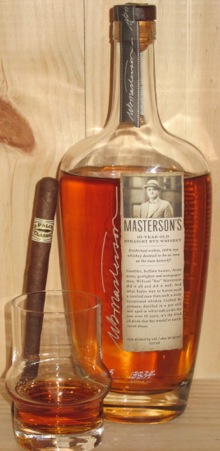 But as the American appetite for rye grew, older rye was suddenly difficult to find, especially if the whiskey company didn’t have their own distillery. So people began turning to unusual sources. One such source was Canada, where this 100% rye was distilled to be blended into Canadian whiskey.
But as the American appetite for rye grew, older rye was suddenly difficult to find, especially if the whiskey company didn’t have their own distillery. So people began turning to unusual sources. One such source was Canada, where this 100% rye was distilled to be blended into Canadian whiskey.
That 100% Canadian rye found its way into three ten-year-old ryes: Jefferson’s, Whistlepig, and Masterson’s. Each has its own character, but the family resemblance is apparent side-by-side.
Masterson’s is the most expensive at $65 to $80. It comes in an elegant bottle adorned with a photo of old west lawman Bat Masterson, whose relationship to the whiskey is tenuous at best.
The 90-proof Masterson’s is light copper-colored and features a nose with clean floral notes and a subtle honey sweetness.
On the palate, there’s more floral notes, rubber band, licorice, and burnt caramel. The finish is long and floral with a hint of apple and lots of spice on the back-end.
In a way, Masterson’s is a test of your devotion to rye. If you really like the quintessential rye flavors (floral notes, a bit of spice, a lack of sweetness) Masterson’s will probably be right up your alley. If you just want sweet bourbon notes with a little extra spice, the 100% rye mash bill of Masterson’s probably won’t be for you.
Personally, I’m a fan. And although, for the price, I’d rather have the $40 Jefferson’s (which, unfortunately, has been discontinued), on taste alone it may be my favorite of the Canadian 100% rye trio.
As for a cigar pairing, I think a Cameroon-wrapped smoke is perfect for the floral spice of Masterson’s. Specifically, try it with the Drew Estate Nirvana, Fuente Hemingway, or La Flor Dominicana Cameroon Cabinet.
photo credit: Stogie Guys

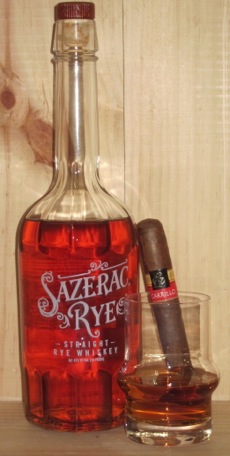 Sazerac, along with
Sazerac, along with 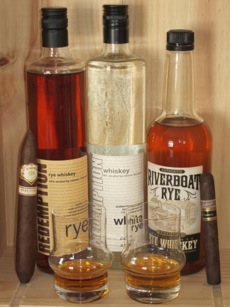 If the Lawrenceburg address sounds familiar, it should. It’s 95/5 rye/malted barley mashbill is the basis of a number of ryes on the market:
If the Lawrenceburg address sounds familiar, it should. It’s 95/5 rye/malted barley mashbill is the basis of a number of ryes on the market: 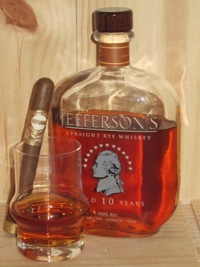 But most Canadian whiskey doesn’t meet the “straight rye” designation since the rye is often mixed with neutral grain spirits (basically vodka), to produce the low-proof, smooth-drinking Canadian whiskey you might be familiar with. And yet lots of rye is made in Canada, which caught the eye of some American whiskey sellers as old aged rye has gained a larger and larger following with American whiskey fans.
But most Canadian whiskey doesn’t meet the “straight rye” designation since the rye is often mixed with neutral grain spirits (basically vodka), to produce the low-proof, smooth-drinking Canadian whiskey you might be familiar with. And yet lots of rye is made in Canada, which caught the eye of some American whiskey sellers as old aged rye has gained a larger and larger following with American whiskey fans.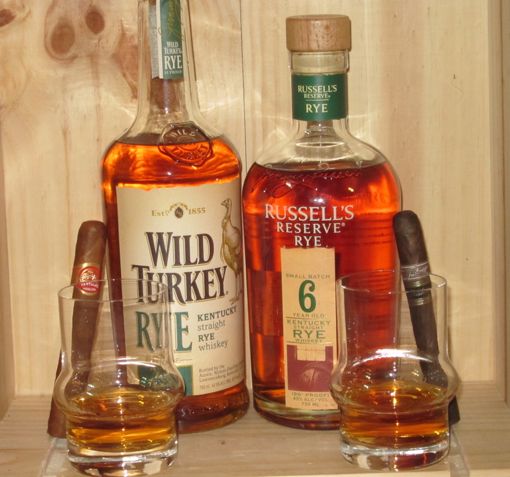
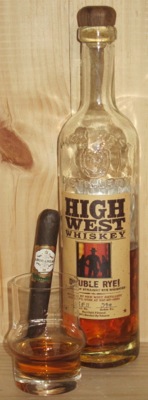 High West distills
High West distills 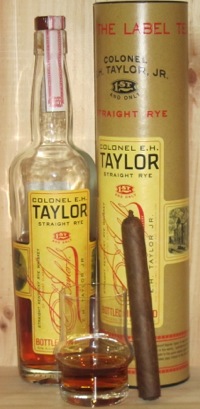 Taylor is one of the founding fathers of the bourbon industry and one-time owner of what is now called Buffalo Trace Distillery. He’s largely known as a proponent of the Bottled-in-Bond Act of 1897, which ensured quality standards for “bottled-in-bond†bourbon (back then many bourbons were mixed with things like tobacco, turpentine, or other horrible additives to appear more aged than they were). But rest assured the Feds weren’t just worried about the quality of our bourbon. The law also ensured that the federal government could more easily collect taxes.
Taylor is one of the founding fathers of the bourbon industry and one-time owner of what is now called Buffalo Trace Distillery. He’s largely known as a proponent of the Bottled-in-Bond Act of 1897, which ensured quality standards for “bottled-in-bond†bourbon (back then many bourbons were mixed with things like tobacco, turpentine, or other horrible additives to appear more aged than they were). But rest assured the Feds weren’t just worried about the quality of our bourbon. The law also ensured that the federal government could more easily collect taxes. Patrick Ashby
Co-Founder & Editor in Chief
Patrick Ashby
Co-Founder & Editor in Chief Patrick Semmens
Co-Founder & Publisher
Patrick Semmens
Co-Founder & Publisher George Edmonson
Tampa Bureau Chief
George Edmonson
Tampa Bureau Chief